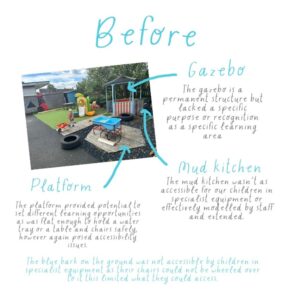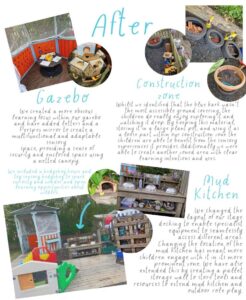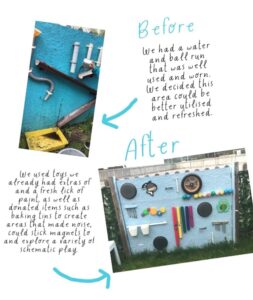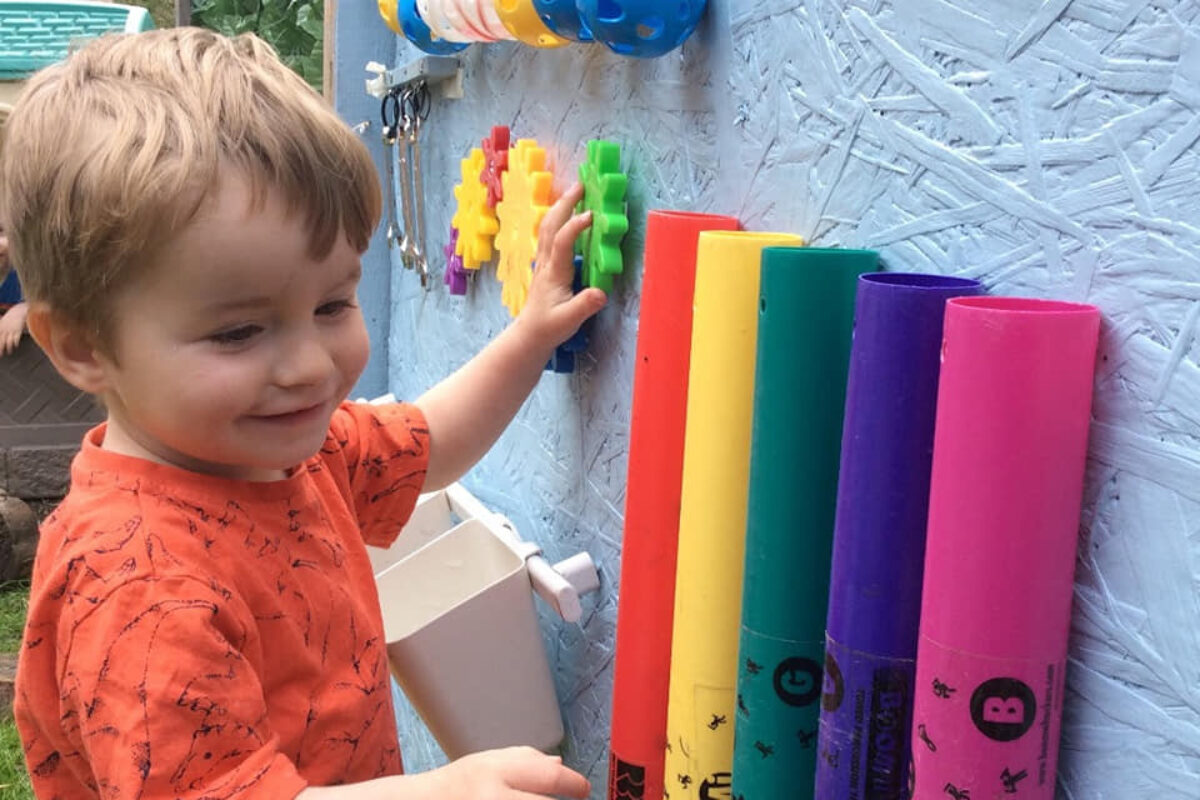Outdoor learning is an integral part of what we do in the early years as it can offer so many experiences and learning opportunities for our children. We know that for some children the opportunities they have to spend time in the outdoors is limited, and through our knowledge of each individual child we can offer a range of experiences that add to and enhance their cultural capital as they learn and grow with us.
Being outdoors supports children’s learning holistically. What better way to discover rain than to feel it on your skin, to jump up and down in the puddles, to listen to the splashing and the pitta patter of the raindrops; can you catch the raindrops in a bucket, can you use the water to make marks on paper, can you talk about what you are seeing, hearing and experiencing? All of these outdoor experiences don’t require more than a bucket, paintbrush and appropriate clothing! With the further input of child centred and open-ended resources the opportunities for children in the outdoor environment can be extended even further. When considering the organisation of your outdoor space, reflect on the areas of learning and look at how they will interlink as children begin to deeply engage with what is provided for them.
By introducing a few planks, tyres and safely stackable crates you can create the opportunity for children to explore their physical development but also other areas of learning in the Early Years Foundation Stage; they may learn to work together to create a pirate ship and go on an adventure, they might build an obstacle course and explore their balance and ability to climb, they could be problem solving working out how many of each resource they need to achieve their goal. Practitioners may have great intentions when they set up an experience for children however something can be anything a child wants it to be and we must be confident to follow children’s interests and let them take the lead in their learning. That stick they find on the floor can be a broom, a steering wheel, it could be Stick Man and he is looking for his next adventure and those leaves can be the path he follows! These two examples demonstrate that simple resources or simply the outdoors itself can provide unlimited opportunities for children to follow their imagination, engage and develop a variety of skills. It is not that we need to spend lots of money on wonderful outdoor specific resources in order to meet the intention of your learning, it is about how we can adapt what we have. There are items all around your settings that can be transferred outside to create an incredible and stimulating learning experience that will have an entirely different impact than they would have done in the indoor environment. Our outdoors does not need to be a replication of our indoors, in fact it should be an extension, a place to consider how we can safely push the boundaries of our children’s learning.
Research demonstrates that different sounds, sights, textures, smells support children with special educational needs to regulate themselves whilst simultaneously promoting brain development and enhancing social skills. Some settings report that their outdoor spaces are missing this sensory stimulation that would largely benefit children. Again, this does not need to be costly process to ensure that we are able to offer sensory play within our outdoor environments. A few potted plants around the garden which include plants such as lavender or parsley will provide children with things to smell, touch and even safely taste. Some sticks, old pots and pans or a windchime will add to the sounds that can be heard and created, but you can also encourage children to listen out for the birds, insects, and vehicles in the area. Having a range of these objects around your outdoor area will encourage children to explore at their own pace and to embrace the natural world around them leading to a greater understanding of the community in which they live.
As a group of settings, we have reflected on the outdoor environment and how they support children’s learning and development. Through these conversations with practitioners, they have been able to consider what works well for their children and what they could change or add to ensure we are offering the best opportunities for each child. These collective conversations were a useful starting point to ensure the team thought holistically about the environment and individual children and were able to create a plan tailored to children’s needs and interests.
They created an action plan which highlighted the need to include more ‘natural’ greenery in some of the gardens to break up the views of hard concrete and man-made materials and structures in the immediate surrounding area. Another area of development they had considered was how they could make all learning opportunities more accessible to all children especially as they enter the more challenging weather conditions.


Together, they worked as a team to plan and implement the changes they agreed and adapted their outdoor environments to reflect the learning needs, styles and interest of the children who access their environment daily.
As you can see, they have focused on enhancing a mixture of the resources and zones available within the garden, and how these could be effectively stored and rotated. Their planning and delivery of outdoor learning opportunities now more effectively reflects the indoor environment, in that they are both set up purposefully and with the learning intentions for children in mind ensuring there’s targeted resources and learning opportunities for each area of the Early Years Foundation Stage.


The ability to reflect on the strengths and areas for development in all our practice is a great way of continuously monitoring the experiences children receive when they are with us and will enhance the skills of all early years practitioners as they will understand why a space is used the way it is or why a child needs resources made available in a particular way because they have taken the time to recognise and understand the unique learning of the individual child.

